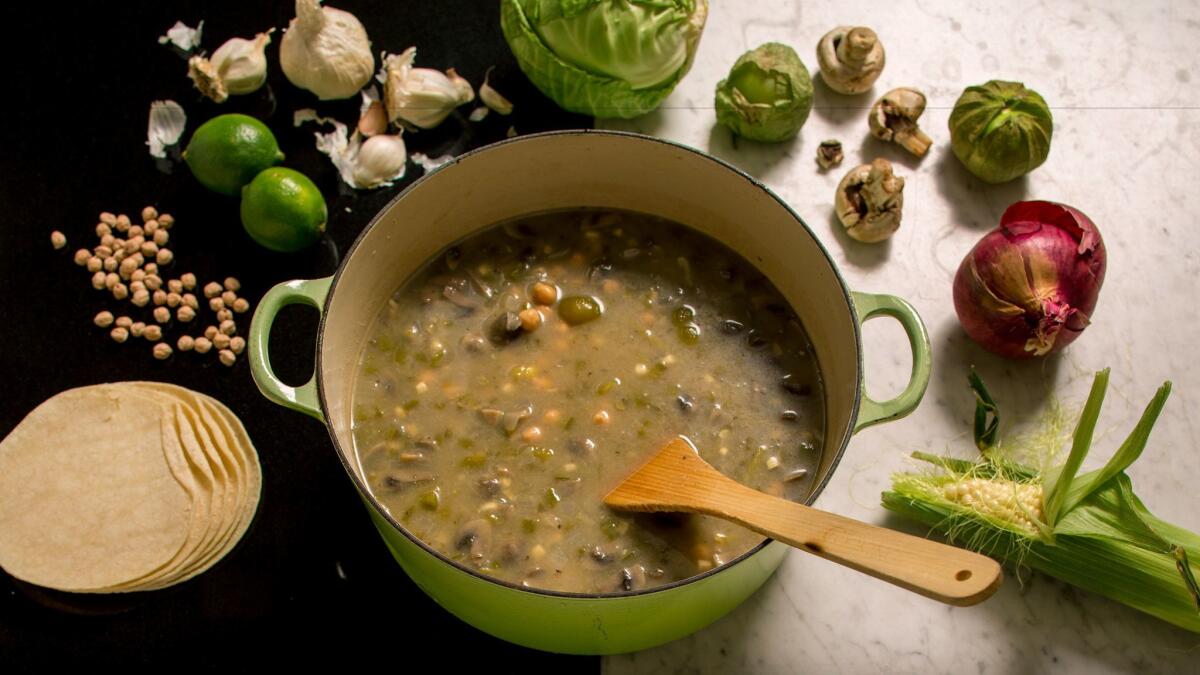Q&A: Make this vegan pozole recipe, and learn tips for combating food waste in the kitchen
Next week, volunteers and culinary students at L.A. Kitchen will be busy gathering, chopping, cooking and preparing vegan garbanzo pozole, “kaleritos” — chips made from kale-based tortilla — and other dishes, each a creative use of leftover, donated or discarded food. But this isn’t being done as part of restaurant service. It’s part of the preparation for the first Los Angeles Feeding the 5000 event on May 4, culminating in a free feast, made entirely from fresh produce and meant to highlight the global issue of food waste.
Founded in 2013 by nonprofit pioneer and speaker Robert Egger, L.A. Kitchen is a nonprofit facility in Lincoln Heights that recovers food items to be used in a culinary arts training program for former inmates and young adults leaving the foster care system. Students, graduates, chefs and volunteers turn the food into healthful meals distributed to nonprofit and community members. Last week, I spoke by phone with Ryan Stewart, L.A. Kitchen’s executive chef, about the upcoming Feeding the 5000 event, as well as tips for combating food waste in the home kitchen.
Combating food waste is nothing new when it comes to restaurants. What are some ways restaurants and professional kitchens address the issue?
Off the top, one of the things that makes it easy to spot food waste in a restaurant is that it bullks up fast. If everyone is prepping leeks, the cooks toss them aside, and before you know it, those leek tops are stacking up fast — particularly if you’re at a restaurant serving 200, 300, even a thousand, people a night. It’s a problem, and you have to get creative.
But what about the home kitchen? You can use those leeks tops, those carrot tops, and those onion peels and make a vegetable stock, then use it to add flavor to a variety of dishes. In restaurants, you really have to find creative ways to use things. With those leeks, I’d blanch them, then process them to make this vibrant green puree I can use in a variety of ways. When you make tomato concasse [where the skins and seeds are removed], you take those leftover peels, dehydrate them and put them in a coffee grinder to make a powder. Drizzle that powder to add tomato flavor on top of food. There are so many ways.
Los Angeles Times Food Bowl: A new kind of food festival »
Using the nose-to-tail movement as an example, how have our changing food tastes incorporated or addressed food waste?
For restaurants, it’s not so much about food tastes as it is about the bottom line. It may be a hot thing now, but we’ve been trying to save and use vegetable and animal scraps forever.
But there is a lot more daring now, at least with diners. It’s kind of funny, in that people are eating pig’s feet and lamb brains, but are just now saying, “Oh, I’ll try that black radish rind,” or, “I’ll try that pesto made with pear leaves.” People are much more adventurous now about trying new things. It’s an exciting way to cook, because you don’t have to limit yourself so much.
It’s a greens-to-root movement.
When a chef is doing something different, you know, with a strange fruit peel, or a root no one’s ever heard of, or even sauteed beet greens, it’s different. There are such pretty things you can do with them.
Vegetables are often becoming the main ingredient and not just a side. That’s another thing that’s really changing. How can vegetables be a main ingredient and still have a full, complete meal?
It comes back to saving money in your household. The more you use, the more you can save. There's so much food, it's a shame to see people putting it to waste.
— Ryan Stewart, executive chef at L.A. Kitchen
How do you plan your meals at L.A. Kitchen?
Our restaurant is different than a lot of restaurants in that we don’t exactly buy things. We get donations. It’s almost like a market everyday, if that makes sense. Let’s say I got a container of winter squash in last week, and this week I get some broccoli that’s on its last legs. The broccoli is going to be used first because the squash will hold for a little while.
In our kitchen, we don’t necessarily choose what to make. We see what is close to going bad, and find a use that would be perfect for it. We take bruised or beat up fruit, and use them in a way that’s to the advantage of the fruit: baking or stewing. Bruising isn’t necessarily a bad thing. If we have mangoes that are still really green, we may chop them into a salad, or use them as part of a slaw, for crunch. On-the-fly cooking is the most fun you can do.
Where do you get your food?
We have a lot of sourcing, and everything comes from the Los Angeles area. Some of it comes from local farms, because they have to grow for their suppliers, and they have to make sure they have enough product to meet their demand. If they grow too much, we work with them. We also work with juicing companies. They can be very strict with their product, and if it doesn’t meet their specs, they can’t use it. We have great drivers who will take everything from vegetables that need to be used quickly to things that are more shelf stable. There’s a local spice company that has extra spice that we’re using for the pozole at the Feeding the 5000 event.
That’s quite a variety.
And this isn’t dumpster diving. This is beautiful stuff that just can’t find a home for whatever reason. If people came down here and saw what we actually cook with — and volunteers do come down — you’ll find beautiful baby carrots, and the stuff you find working in high-end restaurants. It changes with the season.
Any last quick tips to offer readers?
If you’re going to buy fresh herbs such as thyme or sage, don’t put them in the fridge — leave them on your counter. Use them as much as you can, and what you can’t use will actually dry, and you’ll have your own dried herbs in about a week. All of a sudden, that $1.99 bunch of fresh thyme turns into a $3 bottle of dried herbs if you bought it from a spice company.

VEGAN GARBANZO POZOLE
See the recipe on our California Cookbook »
About 1 ½ hours, plus soaking time. Serves 6 to 8
1 pound (about 2 cups) dry garbanzo beans
About 2 tablespoons oil
1 onion, diced
½ cup seeded and diced chiles or peppers, heat level to taste
2 garlic cloves, minced
1 pound mushrooms, quartered
1 pound tomatillos, husked and quartered
2 ½ quarts vegetable broth or water
3 corn tortillas
1 cup fresh corn
1 teaspoon dry oregano
1 teaspoon ground cumin
1 teaspoon salt, more if desired
2 teaspoons lime juice (more if desired), plus lime wedges for garnish, divided
1 cup shredded cabbage
1 cup sliced red onion
1 cup coarsely chopped cilantro leaves
1. Soak the garbanzo beans with at least 2 quarts of water overnight to soften. Drain, rinse and drain again. Set aside.
2. Heat a thin film of oil in a large, heavy pot over medium heat. Add the onion and chiles and cook, stirring frequently, until softened and translucent, 6 to 8 minutes. Add the garlic and cook until aromatic, about 1 minute. Stir in the mushrooms and tomatillos. Cook, stirring occasionally, until the mushrooms and tomatillos have softened and released most of their juice, about 8 to 10 minutes.
3. Stir in the drained garbanzo beans, along with the vegetable broth. Increase the heat so the soup base slowly comes to a boil.
4. While the soup is coming to a boil, toast the tortillas. Heat a skillet or comal over high heat until hot. Briefly toast each tortilla on each side until fragrant and lightly colored. Set aside.
5. Add the toasted tortillas, corn, oregano and cumin to the soup base and reduce the heat to a gentle simmer. Cook the soup, stirring occasionally, until the garbanzos are tender, the tortillas have broken down, and the liquid is reduced so the soup is the desired thickness (if the soup is too thick, add additional broth or water to thin as desired), stirring occasionally, about 1 hour. Stir in the lime juice and salt. Taste the soup and adjust the flavoring and seasoning if desired.
6. Ladle the hot pozole into bowls and garnish with cabbage, onion, lime wedges and cilantro. Serve immediately.
Note: Adapted from a recipe by chef Ryan Stewart at L.A. Kitchen.
Each of 8 servings: calories 311; protein 15 grams; carbohydrates 54 grams; fiber 13 grams; fat 6 grams; saturated fat 1 gram; cholesterol 0; sugar 15 grams; sodium 1,002 mg
ALSO
Why we need to stop throwing out food and thinking of it as a resource
Food Bowl is coming. Here’s our cheat sheet of what to do during the monthlong festival
Can urban farming combat food waste? We chatted with the founders of Alma Backyard Farms
Eat your way across L.A.
Get our weekly Tasting Notes newsletter for reviews, news and more.
You may occasionally receive promotional content from the Los Angeles Times.








